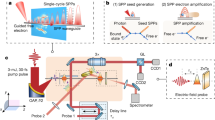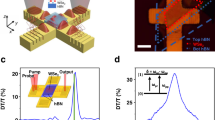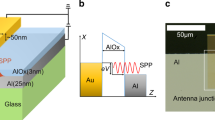Abstract
The phenomenon of slow light is interesting not only from a fundamental physics standpoint, but also because it introduces the possibility of new applications in telecommunications1. For a practical slow-light device, the important features are bandwidth, range of wavelength tunability and size, rather than the absolute slowdown factor achieved2. Slow light can be achieved in three main ways: through quantum interference effects3,4,5,6,7,8, which can slow the speed of light down to several metres per second, albeit within a very narrow bandwidth; by using photonic crystals9, which are able to slow light over large bandwidths but with much smaller slowdown factors10,11; and by using stimulated Brillouin or Raman scattering12,13. Surface plasmon polaritons have the advantage that they can overcome the diffraction limit of light in a microchip-sized device14,15,16,17. Increases in the propagation lengths of surface plasmon polaritons18 and the feasibility of all-optical wavelength tunability19 have been reported. Here we report the observation of slow, femtosecond surface-plasmon-polariton wavepackets. We show that a highly compact (55 µm length) plasmonic structure is able to achieve an effective slowdown factor of two over a 4 THz bandwidth. These results will increase the scope of photonic devices based on surface plasmon polaritons.
This is a preview of subscription content, access via your institution
Access options
Subscribe to this journal
Receive 12 print issues and online access
$209.00 per year
only $17.42 per issue
Buy this article
- Purchase on Springer Link
- Instant access to full article PDF
Prices may be subject to local taxes which are calculated during checkout





Similar content being viewed by others
References
Gauthier, D. Slow light brings faster communications. Phys. World 30 December (2005).
Mok, T. J. & Eggleton, B. J. Expect more delays. Nature 433, 811–812 (2005).
Hau, L. V., Harris S. E., Dutton, Z. & Behroozi, C. H. Light speed reduction to 17 meters per second in an ultracold atomic gas. Nature 397, 594–598 (1999).
Lukin, M. D. & Imamoğlu. A. Controlling photons using electromagnetically induced transparency. Nature 413, 273–276 (2001).
Turukhin, A. V. et al. Observation of ultraslow and stored light pulses in a solid. Phys. Rev. Lett. 88, 023602 (2002).
Bigelow, M. S., Lepeshkin, N. N. & Boyd, R. W. Superluminal and slow light propagation in a room-temperature solid. Science 301, 200–202 (2003).
Bajcsy, M., Zibrov, A. S. & Lukin, M. D. Stationary pulses of light in an atomic medium. Nature 426, 638–641 (2003).
Ku, P. C. et al. Slow light in semiconductor quantum wells. Opt. Lett. 29, 2291–2293 (2004).
Photonic Crystals and Light Localization in the 21st Century (ed. Soukoulis, C. M.) (Kluwer Academic, Dordrecht, The Netherlands, 2001).
Gersen, H. et al. Real-space observation of ultraslow light in photonic crystal waveguides. Phys. Rev. Lett. 94, 073903 (2005).
Vlasov Y. A., O'Boyle, M., Hamann, H. F. & McNab, S. J. Active control of slow light on a chip with photonic crystal waveguides. Nature 438, 65–69 (2005).
Okawachi, Y. et al. Tunable all-optical delays via Brillouin slow light in an optical fiber. Phys. Rev. Lett. 94, 153902 (2005).
Okawachi, Y. et al. All-optical slow-light on a photonic chip. Opt. Express 14, 2317–2322 (2006).
Raether, H. Surface Plasmons on Smooth and Rough Surfaces and on Gratings (Springer, Berlin, Germany).
Ozbay, E. Plasmonics: Merging photonics and electronics at nanoscale dimensions. Science 311, 189–193 (2006).
Barnes, W. L., Dereux, A. & Ebbesen, T. W. Surface plasmon subwavelength optics. Nature 424, 824–830 (2003).
Shin, H. & Fan, S. All-angle negative refraction for surface plasmon waves using a metal–dielectric–metal structure. Phys. Rev. Lett. 96, 073907 (2006).
Bozhevolnyi, S. I., Volkov, V. S., Devaux, E., Laluet, J.-Y. & Ebbesen, T. W. Channel plasmon subwavelength waveguide components including interferometers and ring resonators. Nature 440, 508–511 (2006).
Wurtz, G. A., Pollard, R. & Zayats, A. V. Optical bistability in nonlinear surface-plasmon polariton crystals. Phys. Rev. Lett. 97, 057402 (2006).
Soljačić, M. & Joannopoulos, J. D. Enhancement of nonlinear effects using photonic crystals. Nature Mater. 3, 211–219 (2004).
Gómez Rivas, J., Kuttge, M., Haring Bolivar, P., Kurz, H & Sánchez-Gil, J. A. Propagation of surface plasmon polaritons on semiconductor gratings. Phys. Rev. Lett. 93, 256804 (2004).
Jetté-Charbonneau, S. et al. Demonstration of Bragg gratings based on long-ranging surface plasmon polariton waveguides. Opt. Express 13, 4674–4682 (2005).
Fainman, Y. Invited lecture at OSA Topical Meeting on Integrated Photonics Research and Applications. IPRA/NANO 2006, Uncasville, USA, 24–26 April 2006.
Kretschmann, E. & Raether, H. Radiative decay of nonradiative surface plasmons excited by light. Z. Naturforsch. A 23, 2135–2136 (1968).
Balistreri, M. L. M., Gersen, H., Korterik, J. P., Kuipers, L. & van Hulst, N. F. Tracking femtosecond laser pulses in space and time. Science 294, 1080–1082 (2001).
Betzig, E. & Trautman, J. K. Near-field optics: Microscopy and surface modification beyond the diffraction limit. Science 257, 189–195 (1992).
Russel, P. St. J. Bloch wave analysis of dispersion and pulse propagation in pure distributed feedback structures. J. Modern Optics 38, 1599–1619 (1991).
Settle, M. D. et al. Flatband slow light in photonic crystals featuring spatial pulse compression and terahertz bandwith. Opt. Express 15, 219–226 (2007).
Wilson, W. D. Analyzing biomolecular interactions. Science 295, 2103–2105 (2002).
McFarland, A. D. & Van Duyne, R. P. Single silver nanoparticles as real-time optical sensors with zeptomole sensitivity. Nano Lett. 3, 1057–1062 (2003).
Acknowledgements
This work was made possible by the facilities of the Amsterdam NanoCenter. The work is part of the research programme of the Stichting voor Fundamenteel Onderzoek der Materie (FOM), which is financially supported by the Nederlandse organisatie voor Wetenschappelijk Onderzoek (NWO). Support of the EC-funded project PhOREMOST (FP6/2003/IST/2-511616) is gratefully acknowledged. This work was also partially supported by NANONED, a nanotechnology program of the Dutch Ministry of Economic Affairs. The authors thank Rob Engelen for useful discussions.
Author information
Authors and Affiliations
Contributions
M.S. carried out the experiments, analysed the data and wrote the manuscript. L.K. conceived the experiments, helped with the analysis and co-wrote the manuscript.
Corresponding author
Supplementary information
Supplementary Information
Supplementary methods and figure S1 (PDF 109 kb)
Supplementary Information
Supplementary movie (AVI 1150 kb)
Rights and permissions
About this article
Cite this article
Sandtke, M., Kuipers, L. Slow guided surface plasmons at telecom frequencies. Nature Photon 1, 573–576 (2007). https://doi.org/10.1038/nphoton.2007.174
Received:
Accepted:
Published:
Issue Date:
DOI: https://doi.org/10.1038/nphoton.2007.174
This article is cited by
-
High-Sensitivity Sensor Based on Plasmon-Induced Transparency in Terahertz Borophene Metasurface
Plasmonics (2024)
-
Adjustable Propagation Length Enhancement of the Surface Plasmon Polariton Wave via Phase Sensitive Optical Parametric Amplification
Scientific Reports (2018)
-
Microcavity electrodynamics of hybrid surface plasmon polariton modes in high-quality multilayer trench gratings
Light: Science & Applications (2018)
-
Ultra-wide band dispersionless slow light waveguides
Optical and Quantum Electronics (2018)
-
A seismic metamaterial: The resonant metawedge
Scientific Reports (2016)



